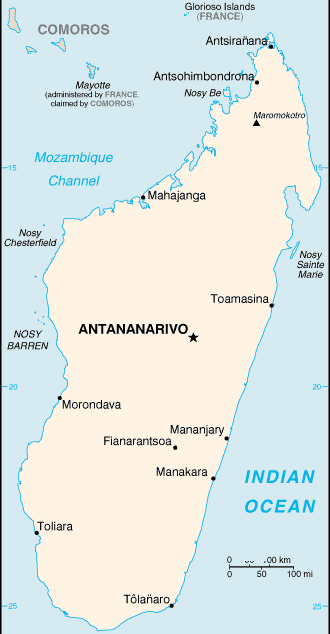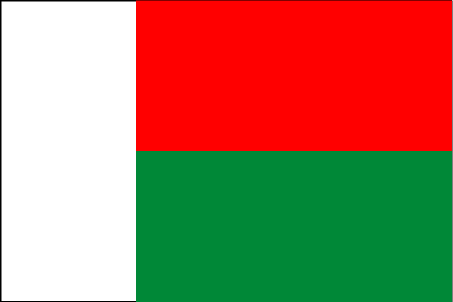
|

Madagascar
Background:
Formerly an independent kingdom, Madagascar became a French colony in 1886, but
regained its independence in 1960. During 1992-93, free presidential and
National Assembly elections were held, ending 17 years of single-party rule. In
1997, in the second presidential race, Didier Ratsiraka, the leader during the
1970s and 1980s, was returned to the presidency. The 2001 presidential election
was contested between the followers of Didier Ratsiraka and Marc Ravalomanana,
nearly causing secession of half of the country. In April 2002 the High
Constitutional Court announced Ravalomanana the winner.
Location:
Location: Southern Africa, island in the Indian Ocean, east of Mozambique.
Area: Total: 587,040 sq km, water: 5,500 sq km, land: 581,540 sq km.
Area - comparative: slightly less than twice the size of Arizona
Coastline: 4,828 km.
Climate and Terrain:
Climate: Tropical along coast, temperate inland, arid in south.
Terrain: Narrow coastal plain, high plateau and mountains in center.
Natural resources: Graphite, chromite, coal, bauxite, salt, quartz, tar sands,
semiprecious stones, mica, fish, hydropower.
People:
Population: 16,473,477.
Ethnic groups: Malayo-Indonesian (Merina and related Betsileo), Cotiers (mixed
African, Malayo-Indonesian, and Arab ancestry - Betsimisaraka, Tsimihety,
Antaisaka, Sakalava), French, Indian, Creole, Comoran.
Religions: Indigenous beliefs 52%, Christian 41%, Muslim 7%.
Languages: French (official), Malagasy (official).
Government:
Government type: Republic.
Capital: Antananarivo.
Independence: 26 June 1960 (from France).
Economy overview:
Madagascar faces problems of chronic malnutrition, underfunded health and
education facilities, a roughly 3% annual population growth rate, and severe
loss of forest cover, accompanied by erosion. Agriculture, including fishing
and forestry, is the mainstay of the economy, accounting for one-third of GDP
and contributing more than 70% to export earnings. Industry features textile
manufacturing and the processing of agricultural products. Growth in output in
1992-97 averaged less than the growth rate of the population. Growth has been
held back by antigovernment strikes and demonstrations, a decline in world
coffee prices, and the erratic commitment of the government to economic reform.
Statistics:
Telephones - main lines in use: 55,000.
Telephones - mobile cellular: 63,100.
Radio broadcast stations: AM, FM 9, shortwave 6.
Radios: 3.05 million.
Television broadcast stations: 1.
Televisions: 325,000.
Internet users: 35,000.
Railways: Total: 893 km.
Highways: Total: 49,837 km, paved: 5,781 km, unpaved: 44,056 km.
Airports: 130.
Airports - with paved runways: 29, with unpaved runways: 101.
Return to Visiting Locations
|



